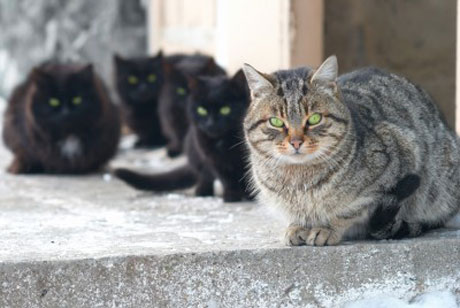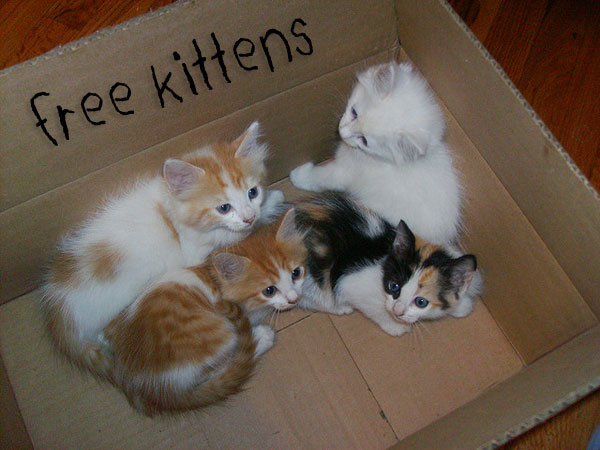A Roundtable Discussion on Cats for Spay/Neuter Awareness Month
Kittens. In my day, it was not uncommon to see a kid holding a box with a litter of them that read, “Free to a good home.” It was also not uncommon to see free kittens advertised in the classified section of the newspaper. And if you were going to the mall, a side trip to the pet store to visit with the kittens (and puppies) was always in order even if you had no plans to buy one. None of these scenarios came with baggage attached as to whether or not there was a larger implication at hand with all of these animals at the ready.
My childhood cat was personally responsible for two litters and back then I had zero knowledge of subjects such as spay/neuter, cat overpopulation, feral cats, euthanization, and TNR. I got to witness her giving birth firsthand and I suppose I was given some sort of magical explanation about her pregnancies by my Mom, because I had absolutely no idea how sex worked back then. We always found homes for her kittens and I would imagine my knowledge and experiences echoed that of just about anyone else born in the early 60’s.

Years ago I had no idea that a kitten could conceive at such a young age. I also did not know they could be spayed or neutered so young either.
As I got older, a general awareness about shelter cats evolved with me, primarily through the maudlin ad campaigns from the American Society for the Prevention of Cruelty to Animals (ASPCA) that left me feeling sad (so much so that I usually changed the channel) and overwhelmed rather than educated. Bob Barker of the Price is Right game show was the one who informed me I should “have my pet spayed or neutered” but neither Bob or the ASPCA caused me to connect the dots in any solid fashion that there would be less cats in the shelters if people spayed or neutered their pets.
I had absolutely no clue of the staggering numbers (millions) of homeless cats living on the streets and in shelters or the horrific numbers of them being euthanized to control the population. My knowledge of spay/neuter came from my vet(s) and it was almost exclusively related to behavioral issues – my female cats were spayed to stop the endless noises associated with a heat cycle and the males were neutered to deter spraying on the furniture and territorial fighting with my other cats.
With February being National Spay/Neuter Awareness Month it got me to thinking about it all – just when did the cat population in shelters and the streets reach epidemic numbers? Was there a watershed moment in time where we can pinpoint when it started or did cat overpopulation exist to the extent it does now when I was younger and we just didn’t know or talk about it? Or is it something that has been gradually happening for years, escalating to the outlandish proportions of today?
We might never know the answer to this because the data available on the estimates of cats brought to shelters and subsequently euthanized is so convoluted and unreliable. I became involved in cat advocacy issues in 2011 and since then, I have read the same numbers every year from the Humane Society of the United States – that 6 to 8 million animals are taken to shelters, 3 to 4 million of them are euthanized, and of those euthanized, 2.7 million of them perfectly healthy and adoptable.

Millions of cats on the streets and in shelters… just when did it all begin and how do we make it stop?
Shouldn’t these numbers change each year and why are they collectively lumped as one category – animals. Wouldn’t it be more beneficial to know the breakdown between cats, dogs, exotic pets, and so on? Yet none of this is possible because there is no central data reporting system in the U.S. to organize these statistics to estimate the numbers of animals entering shelters/rescues or the numbers euthanized on an annual basis.
So what does it all mean – all these numbers, concepts, and questions? I have loved cats my whole life and as I have gotten older, I have certainly become more knowledgeable about them. But before my entrenchment in cat advocacy issues, my knowledge was cursory and all of this begs a larger question – if I had not become an author, blogger, and cat advocate – a role that immerses me daily with like-minded peers, colleagues, experts, and friends, just what would I know today?
Would I have learned enough about spay/neuter, TNR, feral cats, and cat overpopulation from my everyday mainstream life to understand that spay/neuter is not only a safe and humane means of reducing cat overpopulation, but a procedure that helps to ensure a cat lives a longer, happier, and healthier life? Sadly, I have to say that the answer is probably not. I have become self-educated because I now purposely seek out television shows, social venues, and other avenues that are specifically cat related. But think about it – pretend you are not part of cat blogs, rescues, and other cat related venues. Look and listen to the regular world around you. Is the message being relayed in the mainstream world on TV, radio, etc. in such a manner that most people understand why spay/neuter is so important to controlling cat overpopulation?

Teaching responsibility at an early age is one of the most important avenues toward making a difference in reducing cat overpopulation in our world – it just needs to be done at age appropriate stages.
I know when I watch television, the majority of the shows I watch that do happen to mention cats, do it in a derogatory manner for laughs – almost exclusively in a scenario that pits single women and cats together in a stereotypical relationship synonymous with lonely and crazy – certainly nothing educational about that. I think in a general sense most people are aware there are animals in shelters that need a good home. I also think that most people when adopting a pet, would go to a shelter rather than buying a purebred. But do most people truly understand how or why all these animals ended up in the shelter in the first place and how important spay/neuter is for reducing those numbers? I don’t think they do.
And what about our youth who are bombarded all day long with snippets of information from Facebook, Twitter, Instagram, and YouTube? Do they get the message in their everyday lives, enough to make a difference, and if they do, is the information accurate? Do you think lesson plans on spay/neuter and pet responsibility should be mandatory subject matter at some point in grade, middle, or high school to talk about it?

One of the best educational tools to informing the public about the need for spay/neuter is to get the facts straight.
All of these questions got me to wondering about all of you. Do you remember how, when, why or where you learned about the importance of spay/neuter? What do you think is the most effective way to inform people who don’t know that spay/neuter can help control cat overpopulation? And what about kids – what age do you think it is appropriate to start talking to them about spay/neuter? Let’s take Spay/Neuter Awareness Month to heart and get a discussion going so we can try to figure this out so we can help make a difference for our beloved feline friends.
For further information on spay/neuter, cat overpopulation, and additional cat facts, please reference these detailed articles:
Zee & Zoey’s Spay/Neuter Series – The Facts of Life: The 101’s of Kittens and Conception
Zee & Zoey’s Spay/Neuter Series – Cat Overpopulation and the Moral Ethics of Time
Zee & Zoey’s Spay/Neuter Series – Making Sense of Cat Overpopulation When the Numbers Don’t Add Up

























As far as Mum can remember (just after the dinos, or almost), she always had spayed/neuter kitties. Her pawrents taught her as a child (5 y.o) that cats could have many kittens, that you cannot have too many cats at home (really ?) because you should always be able to take well care of each of your anipals, as they are whole member of the family. They explained her later (7 y.o) that the vet “took off the baby bag/the baby seeds” to avoid unexpected kittens. Purrs
Yes… I remember the dinosaurs, too, Swiss Cats. Lovely time back then. Anyhow, glad to hear your Mum was informed about spay/neuter at a young age. I am sure it made a significant difference in who she is today.
Deb,
Wonderful post and shared with love. There’s no question those “free” kittens felt disposable when I was growing up. I often thought how good were those “good homes”. While the shelter stats vary they are collated to species and the numbers have dropped but we need to grow public awareness. I’m involved with the new campaign with Alley Cat Allies about early spay/neuter. Look for my Q & A on Tuesday.
Very good point, Layla. I am sure that many free kittens went to questionable homes in retrospect. Probably lots of them were outdoor cats and mousers. I think in that regard, we have come a long way. Thank you for the share and I will look for your Q & A.
As a kid it was discussed. But I know the dog we got when I was in middle school was neutered. And the cats we got when I was in high school were neutered and from a shelter. I don’t think I knew the true numbers until I got involved in rescue as an adult. However, I have made an effort to educate my niece and let her know the why.
Random Felines – I am not surprised your pets were neutered or that you have made the effort to educate your niece! Good job!
I’ve been thinking about this some more. A lot of shelters (the larger ones anyhow) use similar software for tracking – made by PetPoint. Used correctly, this software tracks intake and outcome. Wouldn’t it be interesting for the company to run a few reports on their end (which I know they can do) and without mentioning shelters, run it by the nation as a whole and by state showing intake numbers and outcome (and this can be done into various things: rescue placement, adoption, euthanasia [which if also done correctly can be broken down by reason]). While it wouldn’t be 100% accurate for everything, it would be an interesting snapshot.
Mommy wuz very furtunate too hav been waised wound lots of anipals so her unnewstood da need fur spay/neuter. And it wuz talked ’bout a lot in FFA (Future Farmers of America) fur all kinds of weasons. And we will never turn down da oppurrtunty to go to da schools to help educate da kiddos ’bout how to tweat kitties and ’bout da purrtance of spay/neuuter and how to purropurrly care fur them, includin’ Vet visits, shots and surgery. But more needs to be dun too educate da public dats fur sure.
Luv ya’
Dezi and Lexi
Dezi and Lexi – It is wonderful to hear that you were involved in such programs when you were a kid and that you continue to educate on pet responsibility.
Here’s my question…we’ve talked about the importance of spaying and neutering our pets for some time now. Are we making any headway on this? Are the numbers of homeless animals going down…even the slightest? How do we make any headway on this?
That’s my question, Island Cats. Just when can we can some new numbers to help gauge how far we have come and what is working and what isn’t. I think educating the youth in mandatory lesson plans is crucial to lasting change.
So glad to see you addressing this. It has become a constant in my life since I have gotten involved in rescue work. I am very frustrated with the general public at their lack of awareness. I speak to people probably daily on trying to spread the word about spay/neutering and the effects of not doing so. I did not understand the devastating numbers of shelter killings and I have lived with and loved animals, especially cats, all my life. What can we do? I see more and more information coming out and that is encouraging but there is so many lives being lost and it seems like there is actual resistance coming from areas like local shelters. We need to fix this!!
Interesting comment, Jane. Why do you suppose you are seeing some resistance?
I have learned more as I have gotten older also. I remember seeing kittens in all the places you mentioned too when I was a kid. I also have mine spayed and neutered now.
You and I are on the same page, Sue!
I’m embarrassed to admit that I didn’t realize very young cats could have kittens – until the feral youngster who lived on my deck delivered three kittens! I got educated fast. I found those kittens homes and trapped the momma for her spay appointment. After that I started volunteering at a shelter- more than 13 years ago now. With all the TNR work going on in my area, I’m amazed at the continuing influx of Spring kittens.
In spite of all the TNR going on in our area, we ALWAYS get slammed during “kitten season.” I’d hate to think what it would be like if there were not such efforts being made!
Question sitting at home with my two new siamese kittens both scheduled for neuter this month and next is all this a problem amongst so called exotic cat as siamese,Persian,etc most breeders have contracts with neuter/spray a must I have no contracts go vets/what I here words.
Deb, I honestly can’t say when I actually remembering hearing for the first time of spay/neuter
I grew up around a multitude of farms/farmers and having several cats on one farm was a must
I do think the spay/neuter movement is gaining some momentum, probably not nearly as fast as it
should or as all of us would like, but even in the past ten years or so, one see’s or hears about it much
more than before…though it may be because I am more “focused” on the issue ?
As far as telling kids about spay/neuter; if they can be learning about the “birds and the bees”…they can
be learning about spay/neuter
I’ve saved your image and will post it on my blog side bar if this is OK…it’s an awesome graphic !! ♥♥
Laura
Deb, thank you for sharing.
I have so many thoughts on this topic. It’s a passion of mine and you help give the discussion a solid framework with statistics that are simply staggering. I’m hoping that the positive impact of social media is such that the stigma associated with going to a shelter to adopt a kitty is melting away, and with it the belief that one has to adopt from a person they know/breeder, pay a lot of money, and the false notion that adopting a kitten is the only way to ensure you can properly train them to live in your household.
I’ve even struggled with TNR. Not the T and not the N, but the R–because I want that R to stand for re-home instead of release. However, we have a situation in our neighborhood area where we have removed one male (he is now living a very comfortable life) that was part of the breeding problem with a female feral. And guess what? A new male showed up. So we must, must TNR her. And that R is probably going to mean release as we have come up short on places to foster while we search for homes.
I know for sure she will be healthier and stronger once she is spayed. The constant birthing and struggling to feed kittens is truly taxing and these poor kitty mamas die because they are worn ragged. Our TNRed kitties in the feral colony are happy, get along and seem to be healthy. We want this mama to have that same opportunity, so she is the next target.
Fingers crossed that the message continues to flow to caring people and those who are under informed. Knowledge is the key to making a change.
This is such great advice. Breaks my heart when the shelter always has so many kittens in need of a loving home.
Wonderful PSA post… great advice and well written!
We are fairly aggressive up here in the north country about spay/neuter, but still the number of fertile cats is estimated about 100,000. That is a lot of potential kittens – usually holed up in barns. Our SpayNeuterNow group recently fixed a barnful of cats – 41 of them. It didn’t start out that high of course, but doesn’t take long. Yes, knowledge is the key, and so is affordable, easily accessible spay/neuter and legislation favoring TNR and mandatory spay/neuter before selling/adopting.
Lovely article! It is such an important problem facing us today. <3
This is a great post. I believe that the majority of people have no idea of the amount of senseless killing that goes on in our countries shelters each year. The numbers should definitely fluctuate and since they don’t, we can only assume they aren’t factual. It is mostly a matter of “You don’t know what you don’t know” and When you know better, you do better.” You are doing a fantastic job speaking for the cats. I believe spay/neuter should be taught in schools, but people freak out about anything that has to do with sex so even with animals, I don’t see it happening.
Great post. And such an important topic!
I can’t remember when I learned about the concept either. I was explaining the concept to my young cousins the other day. I don’t know how much they retained!
It is so important to keep this topic in everyone’s awareness – thank you for your efforts in this area. You are so right, interfacing with the youth, getting them while young, is where some of the most important work is occurring!